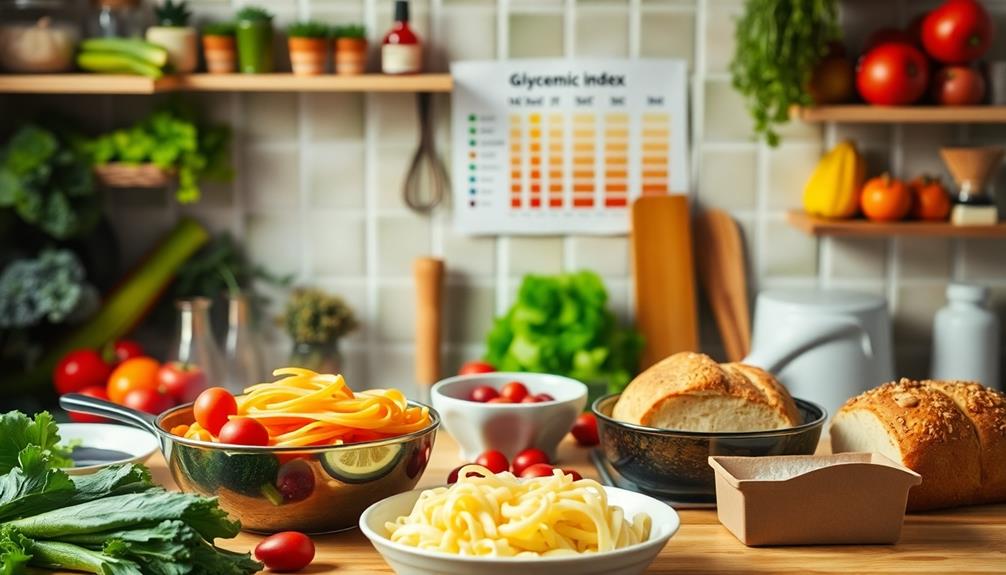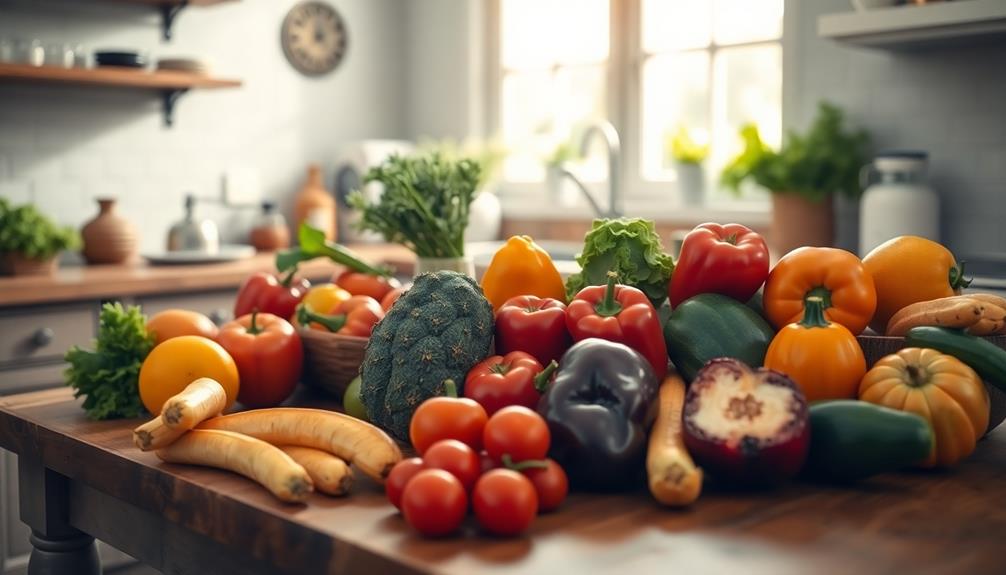Cooking methods can greatly affect the glycemic index (GI) of carbohydrates, which influences how your body handles blood sugar. Boiling and steaming tend to lower the GI by preserving fiber, while frying and baking often raise it by breaking down complex carbs and caramelizing sugars. Cooking for long periods or at high temperatures can increase GI as well. Including acidic ingredients, like vinegar, can slow down carb absorption, further influencing GI. By understanding these methods, you can make better food choices and potentially improve blood sugar control. Discover more tips to optimize your cooking for health benefits.
Key Takeaways
- Cooking methods like boiling and steaming generally lower the glycemic index (GI) of carbohydrates compared to baking or frying, which raise GI levels.
- Prolonged cooking time and higher temperatures can increase GI by breaking down complex carbohydrates and caramelizing sugars.
- Incorporating acidic ingredients, like vinegar, can slow carbohydrate absorption, effectively lowering the GI of a dish.
- Cooling and reheating starchy foods can transform digestible starches into resistant starch, significantly reducing their glycemic response.
- Combining high GI foods with fiber, protein, and low GI options helps moderate blood sugar levels and improves overall glycemic control.
Understanding Glycemic Index
When you eat carbohydrates, they don't all affect your blood sugar the same way. This variation is measured by the Glycemic Index (GI), which ranks foods on a scale from 0 to 100, with glucose scoring 100. Foods are classified as low GI (55 or less), medium (56-69), or high GI (70+).
Understanding this classification is vital, especially if you're managing blood sugar levels or preventing type 2 diabetes. For instance, incorporating dishes like Red-Braised Pork Belly that emphasize slow braising can lead to a more favorable GI profile due to their preparation methods.
Cooking methods play a significant role in determining a food's GI. For instance, boiling or steaming often results in a lower GI compared to frying or baking. Furthermore, the digestibility of starches increases with cooking; overcooking pasta can elevate its GI, while al dente preparation keeps it lower.
Incorporating dietary fiber into your meals can also moderate the GI, as it slows down carbohydrate absorption. If you combine high GI foods with low GI options, you can help control blood sugar spikes.
Factors Influencing Glycemic Index
Several factors influence the Glycemic Index (GI) of carbohydrates, shaping how they affect your blood sugar levels. The cooking methods you choose play a significant role. For instance, boiling and steaming typically lead to a lower GI, while frying or baking can elevate it due to simpler sugars forming during the process.
In Brazilian cuisine, for example, the preparation of dishes like Caldeirada showcases how stewing can enhance flavor while maintaining a lower GI.
Here are a few key factors to evaluate:
- Cooking duration and temperature: Prolonged cooking breaks down complex carbohydrates, raising GI, while steaming helps preserve fiber content.
- Type of carbohydrate: High amylose content often results in lower GI, whereas high amylopectin can lead to higher GI, especially with certain cooking methods.
- Presence of acidic ingredients: Adding vinegar or other acidic ingredients can slow carbohydrate absorption, modifying the overall GI.
Additionally, retrogradation—where cooked starches cool and form resistant starch—can lower GI, making reheated or cooled starchy foods less impactful than freshly cooked ones.
Overview of Cooking Methods
Cooking methods profoundly impact both the nutritional content of foods and their glycemic index (GI). You might be surprised to learn how different methods can affect your meals. For instance, boiling and steaming typically retain more nutrients and fiber, resulting in lower GI values, much like how fresh ingredients are preserved in Nettle and Potato Soup.
On the other hand, frying can increase the GI considerably, especially with starchy foods like potatoes. This occurs because frying promotes the formation of simpler sugars.
When you boil low GI foods, like certain vegetables, the impact on their GI is minimal. Steaming not only preserves texture but also keeps nutrients intact, offering a lower GI outcome.
Be cautious with cooking time, as prolonged cooking can break down complex carbohydrates, raising the GI, particularly in pasta dishes.
Temperature matters too; higher cooking temperatures can caramelize sugars, leading to increased GI levels. For effective blood sugar management, consider lower-temperature cooking methods.
Boiling and Steaming Effects
Boiling and steaming are two cooking methods that can greatly influence the glycemic index (GI) of your meals. These techniques often preserve the beneficial properties of low GI foods, helping you manage your blood sugar levels effectively.
For a fun twist on meal prep, consider incorporating themed snacks like Graveyard Taco Dip or Monster Mash Avocado Toast into your routine!
Here's what you should know:
- Minimal GI impact: Boiling low GI foods tends to keep their GI stable, while steaming retains both texture and nutrients, often resulting in a lower GI.
- Cooking time matters: Prolonged boiling or steaming can break down complex carbohydrates, potentially raising the GI. So, keep an eye on those cooking times!
- Fiber retention: Both methods help retain fiber, which slows digestion and further aids in controlling blood sugar levels.
For example, studies show that boiled potatoes generally have a lower GI than fried ones, highlighting how important cooking methods are in carbohydrate digestibility.
By choosing boiling or steaming over other methods, you can enjoy meals that support better blood sugar management while still savoring delicious foods.
Baking and Frying Considerations
Baking and frying can greatly impact the glycemic index (GI) of your meals, often leading to unexpected blood sugar spikes.
When you bake starchy foods like potatoes at high temperatures, caramelization occurs, which raises simple sugar levels and accelerates sugar absorption into your bloodstream. This process can markedly increase the GI of your meal. For instance, certain Indian dishes such as Mushroom Masala may use various cooking techniques that influence their carbohydrate profiles.
Frying, on the other hand, considerably lowers the resistant starch content of foods, further elevating the GI. Fried potatoes lose amylose levels, making them more digestible and resulting in a GI that often exceeds 70, categorizing them as high GI foods. This means you could experience rapid spikes in blood sugar levels after consuming fried dishes.
While baking typically preserves the food's structure and fiber better than frying, it can still increase the GI compared to boiling or steaming, especially if higher temperatures are used.
Cooling and Its Impact
After exploring the effects of baking and frying on glycemic index, it's important to contemplate how cooling can further influence the carbohydrate profile of starchy foods.
For instance, traditional dishes like Muamba De Galinha, which often accompany rice, highlight the importance of carbohydrate preparation in various cultures. When you cool cooked starchy foods like pasta or rice, a process called retrogradation occurs, transforming digestible starches into resistant starch. This can lower the glycemic index (GI) by up to 40%, greatly impacting your blood sugar levels.
Here are some benefits of using cooling as a strategy:
- Lower Glycemic Response: Cooled and reheated starchy foods can yield a 20-30% lower glycemic response compared to freshly cooked versions.
- Resistant Starch Retention: Reheating cooled starchy foods allows you to retain some of the lower GI benefits, thanks to the presence of resistant starch.
- Better Glycemic Control: Incorporating cooled starchy foods into your meals can help improve glycemic control, especially for those managing diabetes.
Role of Food Combinations
When you combine high glycemic index (GI) foods with low GI options, you can help stabilize your blood sugar levels.
For instance, pairing a high GI food like white rice with a side of Umeboshi (Pickled Plum) can enhance the overall meal by introducing beneficial nutrients and flavors.
Adding protein and fiber to your meals not only slows down digestion but also reduces the overall glycemic response.
Plus, timing your meals can further enhance these benefits, making your food combinations even more effective for managing blood sugar.
Combining High and Low GI
Balancing your meals by combining high glycemic index (GI) foods with low GI options can greatly improve your blood sugar control.
When you pair high GI foods, like white bread, with low GI foods, such as legumes, you can moderate your overall glycemic response. This approach helps lower postprandial blood glucose levels, reducing the risk of spikes.
For instance, incorporating a dessert like Kue Putu made with rice flour and coconut can provide a delightful low GI alternative when enjoyed in moderation.
Consider these effective combinations:
- High GI foods with fiber-rich foods: Vegetables can slow digestion, leading to a gentler blood sugar rise.
- High GI foods with protein or healthy fats: These nutrients can slow carbohydrate absorption, minimizing the glycemic impact.
- High GI foods with acidic ingredients: Adding vinegar can alter gastric emptying rates and enhance insulin sensitivity.
Protein and Fiber Impact
Combining high glycemic index (GI) foods with protein and fiber not only helps regulate blood sugar levels but also enhances the nutritional quality of your meals. For instance, when enjoying a dish like squash casserole, adding some lean meat or beans can improve the meal's overall GI impact.
When you pair carbohydrates with protein sources like legumes or lean meats, you slow down the digestion and absorption of sugars. This leads to a reduced glycemic response, which is vital for managing your blood sugar levels.
Incorporating dietary fiber, especially soluble fiber found in oats and beans, can further lower the GI of your meals. This type of fiber forms a gel-like substance that slows carbohydrate digestion, greatly affecting your post-meal blood sugar.
Studies show that higher fiber content can result in a 20% to 30% decrease in postprandial blood glucose levels compared to low-fiber meals.
Additionally, pairing high-GI foods with fiber-rich vegetables or healthy fats can help mitigate blood sugar spikes, giving your meal a lower glycemic load.
The combination of protein and fiber also enhances satiety, reducing overall carbohydrate intake over time. By making these thoughtful food combinations, you can better manage your blood sugar and enjoy more balanced meals.
Meal Timing Considerations
Meal timing plays an essential role in how your body manages blood sugar levels, especially in relation to food combinations. By strategically pairing carbohydrates with proteins and healthy fats, you can slow down digestion, which helps reduce the glycemic response.
For instance, incorporating high-fiber foods, such as whole grains or legumes, can lower the overall glycemic impact of your meal, promoting better glycemic control. Additionally, traditional Italian dishes like Agnolotti often feature rich fillings that provide a balance of nutrients. This combination not only stabilizes glucose levels but also enhances satiety.
To optimize your meals, consider these tips:
- Incorporate high-fiber foods: They lower the overall glycemic impact of your meal, promoting better glycemic control.
- Space your carbohydrate intake: Smaller, more frequent meals throughout the day can prevent blood sugar spikes.
- Add acidic foods: Ingredients like vinegar or lemon juice can alter gastric emptying rates, further reducing postprandial glucose levels.
Glycemic Index of Common Foods
Understanding the glycemic index (GI) of common foods is essential for managing your blood sugar levels effectively. Foods are classified into three GI categories: low (55 or less), medium (56-69), and high (70+).
Low GI foods, like whole grains, legumes, and non-starchy vegetables, release glucose slowly, helping stabilize your blood sugar. In contrast, high GI foods such as processed snacks, sugary drinks, and white bread spike your blood sugar quickly.
Cooking methods can greatly affect a food's GI. For example, boiling potatoes results in a lower GI compared to frying, which increases GI due to the formation of rapidly digestible starch.
Additionally, the ripening process of fruits impacts their GI; ripe bananas have a higher GI than unripe ones. This means that even the same fruit can have different effects on your blood sugar depending on its maturity.
Dairy products typically have a low GI, making them a smart choice for individuals focused on managing blood sugar.
Nutritional Implications of Cooking
When you choose your cooking techniques, remember they can greatly affect the glycemic index of your meals.
For instance, opting for methods like boiling or steaming can help keep the GI lower, while high-temperature cooking might raise it.
Additionally, incorporating resistant starch through cooling can enhance your meal's nutritional profile, making it easier on your blood sugar levels.
Cooking Techniques Impact GI
Cooking techniques greatly influence the glycemic index (GI) of foods, which is vital for managing blood sugar levels. Different cooking methods can lead to varying effects on how your body processes starchy foods. Here are a few key factors to take into account:
- Cooking duration: Prolonged cooking times can break down complex carbohydrates, increasing the GI.
- High cooking temperatures: Methods like baking or grilling can caramelize sugars, raising the glycemic load.
- Acidic ingredients: Incorporating items like vinegar or citrus can slow carbohydrate absorption, helping to lower post-meal GI responses.
When you boil or steam starchy foods, you often preserve their texture and nutrients, leading to a lower GI.
On the other hand, cooling cooked starchy foods like pasta can induce retrogradation, creating less digestible structures that lower their GI.
Resistant Starch Benefits
Many people aren't aware of the powerful benefits of resistant starch (RS) when it comes to dietary choices. RS behaves like dietary fiber, helping regulate blood sugar levels by slowing carbohydrate digestion and absorption. This can lead to lower glycemic index (GI) values, making it a smart choice for those concerned about blood sugar spikes.
Cooking methods play an important role in RS content. For example, if you fry potatoes instead of boiling or microwaving them, you'll often find higher levels of RS. Foods rich in RS, like cooled cooked potatoes or pasta, can reduce starch hydrolysis and lower the glycemic response by up to 40%. This not only helps keep your blood sugar stable but also provides other health benefits.
Incorporating more RS into your diet can improve gut health, enhance satiety, and greatly reduce the risk of metabolic diseases like type 2 diabetes.
Practical Tips for Cooking
A few simple cooking techniques can greatly influence the glycemic index of your meals. By making mindful choices in your cooking methods, you can keep your meals healthier and lower their GI. Here are some practical tips to take into account:
- Cook starchy foods al dente: Boiling potatoes or pasta until they're firm helps maintain a lower GI. Overcooking can increase their glycemic index.
- Incorporate acidic ingredients: Adding vinegar or lemon juice can slow carbohydrate absorption, resulting in a lower postprandial glycemic response.
- Use healthy fats: Sautéing or stir-frying with olive oil not only enhances flavor but also helps slow digestion, lowering the glycemic load of your meals.
Additionally, try steaming vegetables and whole grains to preserve their fiber content. This helps create a lower glycemic response compared to frying or baking.
Cooking and then cooling starchy foods, like rice or potatoes, can also induce retrogradation, reducing their digestibility and further lowering their GI impact by up to 40%.
Frequently Asked Questions
How Does Cooking Affect the Glycemic Index?
Cooking changes the glycemic index by altering food's structure and digestibility. If you boil or steam, you'll likely keep the GI low, while frying or overcooking can raise it considerably. Choose your methods wisely!
How Does Cooking Affect Carbohydrates?
Cooking changes carbohydrates by breaking down their structures, making them easier to digest. You'll notice that different methods, like boiling or frying, can greatly alter how your body processes these carbs and their nutritional impact.
Does Roasting Increase the Glycemic Index?
Yes, roasting can increase the glycemic index of foods. When you roast starchy items, the sugars caramelize, leading to simpler sugars that your body absorbs more quickly, resulting in a higher glycemic response.
Does Cooking Pasta Twice Reduce Carbs?
Sure, you can cook pasta twice and feel like a culinary genius, but guess what? It actually reduces carbs! Your body's like, "Thanks for the resistant starch!" Enjoy your low-GI meal, you clever chef!
Conclusion
In the grand kitchen of life, the way you cook can transform your meal's impact on your body. Just like a magician's wand can change a rabbit into a dove, your choice of cooking methods can lower the glycemic index of carbohydrates, keeping your energy steady and your cravings at bay. So, embrace boiling, steaming, or thoughtful food combinations, and turn your ordinary dishes into healthful delights that nourish both body and soul.









